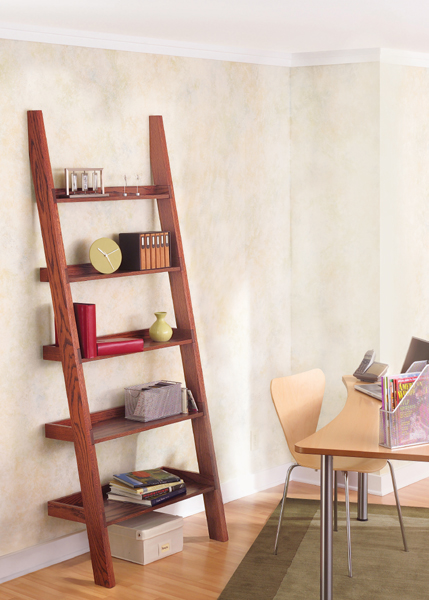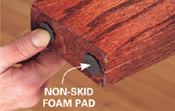

WHAT IT TAKES
Time: 1 day
Skill level: Beginner
This shelf unit may look lightweight and easy to topple. But don’t be fooled. It’s a real workhorse. The 33-1/2-in. x 82-3/4-in. tower features five unique, tray-like shelves of different depths to hold a wide variety of items up to 13-1/4 in. tall. Despite its 10-degree lean, the unit is surprisingly sturdy, and its open design won’t overpower a room.
Whether you choose to make this piece more functional, as in this office setting, or place it in a family room to showcase treasures, the basic construction is the same. Select the type of wood and stain or paint to dress it up (or down) to fit the look of any room.
All the materials can be purchased at home centers or lumberyards. The only special tools you’ll need are a power miter saw for crisp angle cuts and a brad nailer for quick assembly and almost invisible joints. And you’ll have to rustle up an old clothes iron for applying oak edge-banding. Once you’ve gathered all the material, you can build the shelf unit in one afternoon.
This unit was built with red oak and oak veneer plywood and finished with two coats of red oak stain. The beauty of this project is that any wood species will work. If you plan to paint it, select alder or aspen for the solid parts and birch for the plywood.
One note when buying boards: Use a tape measure to check the “standard” dimensions of 1x3s and 1x4s. They sometimes vary in width and thickness. Also check the two full-length 1x4s you plan to use as the uprights to be sure they’re straight, without warps or twists. And always examine the ends, edges and surface for blemishes or rough areas that won’t easily sand out.
Lay a couple of 2x4s across sawhorses (Photo 1) to cut the half sheet of 3/4-in. plywood cleanly and without pinching the saw blade. Since all five shelves are 30-1/2 in. wide, cut this width first, making sure the grain will run the long way across the shelves. Remember to wear safety glasses, earplugs and a dust mask. Make a homemade jig to fit your circular saw and clamp it to the plywood.
Next, cut all five shelf depths, starting with the smallest shelf (3-3/8 in.) first. Cut smallest to largest so you’ll have enough wood to clamp the jig. Important: Make sure you account for the width of your saw blade when you cut each shelf.
Now mark and cut the top of all four 1x4 uprights (the end that rests against the wall), according to Photo 3 and the two dimensions provided in Figure B. Use a sharp blade in your circular saw to prevent splintering.
Select the best front of each plywood shelf, clamp it to the bench on edge and sand it smooth with 150-grit paper on a sanding block. Then preheat a clothes iron to the “cotton” setting and run it over the top of the edge-banding veneer, making sure the veneer extends beyond all edges (Photo 4). Roll it smooth immediately after heating. Let each shelf edge cool for a couple of minutes before trimming and sanding the edges.
Now enter the miter saw, which you use to make all the 90-degree straight cuts first (five shelf backs and 10 shelf sides; see Cutting List). Important: Remember that one end of each shelf side has a 10-degree cut, so first cut them square at their exact length, then cut the angle carefully so the long edge of each piece remains the same.
Next, rotate the miter saw table to the 10-degree mark and cut all the angle pieces. First cut the bottom of both uprights so each upright rests flat against the floor and wall (see Figure A). Then trim the top of the upright to match the bottom, being careful to maintain the 84-in. total length. Next, cut the cleats based on the Cutting List dimensions, which are measured edge to edge (Photo 5 and Figure A). Leave the top cleats long and cut them to exact fit during assembly. Then, to speed finishing, use an orbital sander with 150-grit sandpaper to smooth all pieces before assembly.
To begin assembly, lay out both uprights and all cleats to ensure that the angles are correct so the shelves will be level when the unit is against the wall. Then glue and nail the first cleat flush with the base of each upright (using five or six 1-1/4-in. brads) on each cleat. Work your way upward using 1x3 spacers (Photo 6). Make sure the spacer is the exact same width as the shelf sides! Set these aside to dry.
For shelf assembly, first glue and nail on the shelf backs. Next, apply the sides with glue and nails (Photo 7).
For final assembly, lay one upright on 2x4s, then clamp on the shelves as shown in Photo 8. Apply the glue, position the second upright on top flush with the front edge of the shelves, then sink four 1-1/4-in. brads into each shelf from the upright side. Carefully turn the unit over and repeat the process to attach the second upright. Work quickly so the glue doesn’t set. Lift the ladder shelf and place it upright against a straight wall. Check it with a framing square and flex it if necessary to square it up and to make sure that the uprights rest flat against the floor and wall (assuming your floor is level). Attach three bar clamps as shown in Photo 9 while the glue dries.
The shelf is highly stable as designed, but once you’ve stained or painted it, you can add self-adhesive foam gripping pads to the bottom of the uprights. And if you don’t feel secure having it on a slippery floor, the unit’s width is perfect for screwing the top of the uprights into wall studs.
